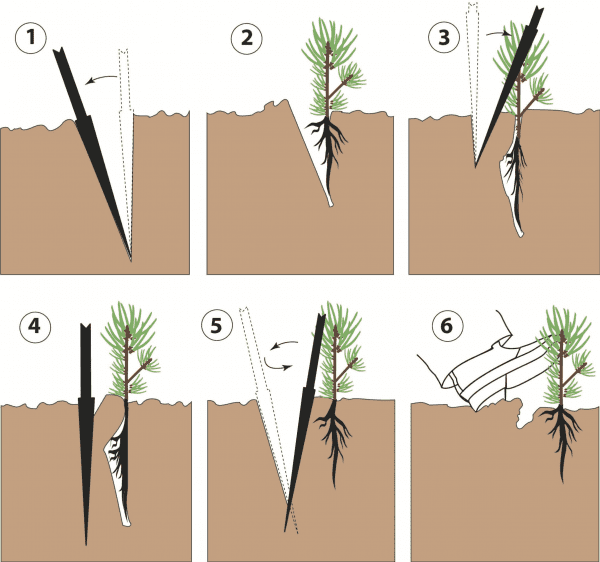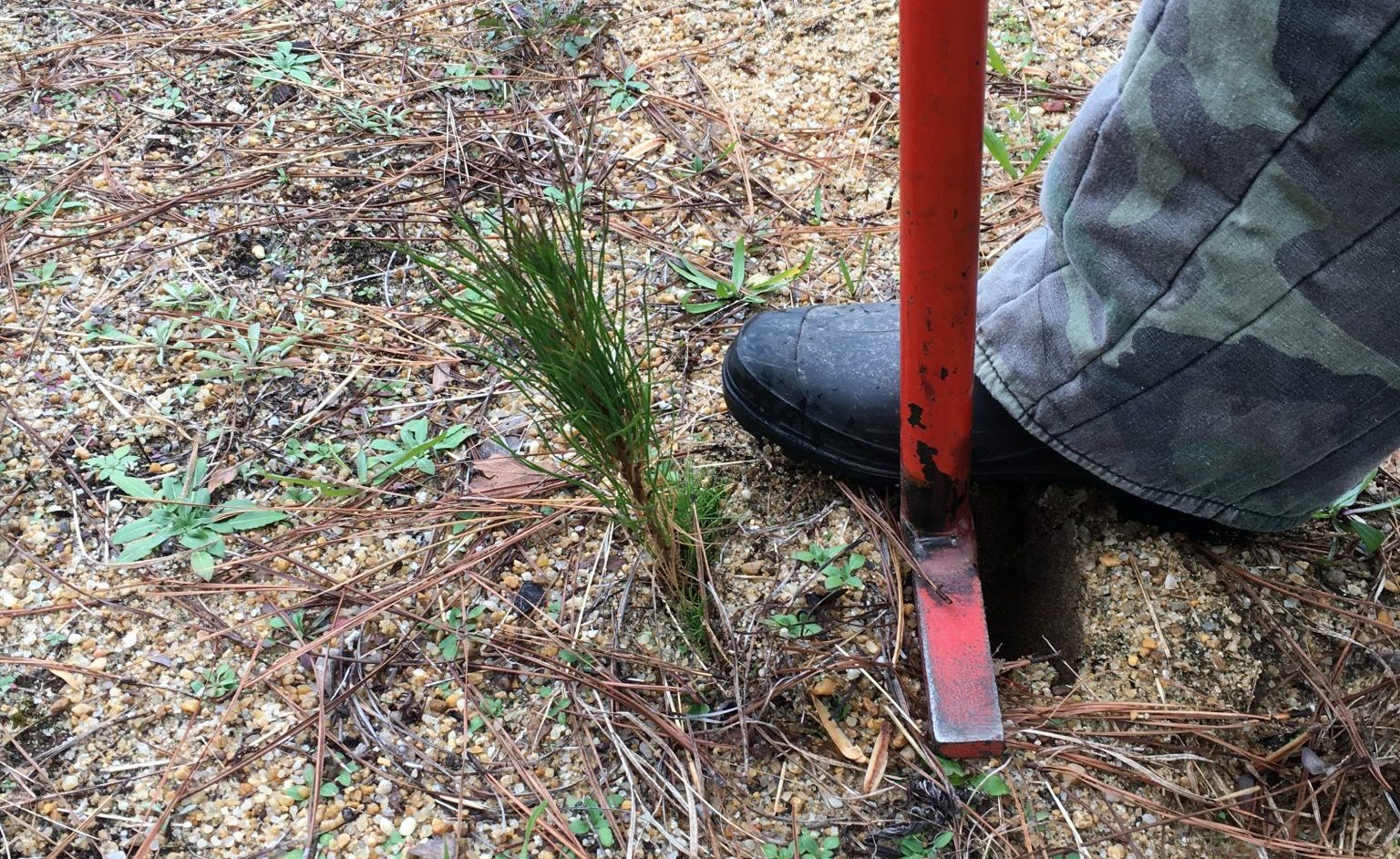Forestry

Learn about proper southern pine tree seedling planting techniques for forested settings.
One of the main objectives of a forest tree nursery is to ensure the production of high-quality tree seedlings that can reach their genetic potential once they are outplanted. This information sheet is intended to draw attention to the issues that can adversely affect both the growth and survival of seedlings once they have left the care of the forest tree nursery. Understanding the factors that can affect the quality and survival of tree seedlings will result in a greater chance of a successful forest plantation, whether it is for timber production, wildlife habitat, recreation, water quality protection, etc.
Good seedling quality can easily be negated by factors not limited to:
- Improper planting, which includes poor planting techniques, ignoring existing site conditions.
- Planting when environmental conditions indicate otherwise.
- Planting of poor quality tree seedlings. Seedlings with a larger root collar diameter have larger root systems, which is directly related to increased survival and early spring establishment. Planting seedlings that are deemed culls (root collar diameter < 3.2 mm) should not be allowed.
- Improper handling of seedlings in the field.
- Improper transportation and storage of seedlings before planting.
Planting of Seedlings
Proper planting ensures that seedlings, once placed into the ground, will optimize their growth and survival. These are often affected by environmental factors and planting techniques.
Environmental Factors
Planting Season
- Pine seedlings should be lifted from the nursery when they are dormant.
- Bareroot seedlings should be planted from November to mid-February.
- Seedlings should be planted early enough to allow for root growth to start before bud break occurs.
- Planting early allows seedlings to obtain good chilling hours (cumulative number of hours of exposure to a specified range [32 to 46 degrees F] of cold temperatures) for freeze tolerance.
- Plant seedlings early in the planting season for good seedling nutrition.
Planting Weather
- Critical at the time of and shortly after planting (table 1).
- Seedlings can rapidly die due to moisture loss as a result of high temperature, low relative humidity, or wind speed.
- Seedling survival is seriously affected when temperatures are considered critical (< 32 or > 85 degrees F).
Table 1. Weather Guidelines for Planting Southern Pine Tree Seedlings
| Temperature (° F) | Relative humidity (%) | Wind speed (mph) | |
|---|---|---|---|
| Normal | 33–75 | > 50 | < 10 |
| Marginal | 76–85 | 30–50 | 10–15 |
| Critical | < 32 or > 85 | < 30 | > 15 |
Soil Conditions
- Avoid dry soil at the time of planting, as this is related to seedling mortality (table 2), especially for seedlings planted later in the season.
- Never plant seedling if soils are frozen.
- For a high or perched water table, delay planting until the soil dries and water table recedes.
Table 2. Soil Moisture Guidelines for Planting Southern Pine Tree Seedlings
| Available soil water, % of field capacity | |
|---|---|
| Normal | 75–100 |
| Marginal | 50–75 |
| Critical | < 50 or > 100 |
Planting Techniques
Seedlings can be planted either mechanically or by hand (for example, using a dibble bar [figure 1]).
- Handle seedlings with care after picking them up from the nursery and avoid conditions that may cause seedling stress (desiccation, freezing, or overheating).
- Plant seedlings as soon as they arrive at the planting site.
- Create a good planting hole.
- For loblolly, slash, and shortleaf pine, plant at least 8 inches deep on sandy dry sites (> 1.5 inches above the root collar), less so on wet sites.
- For longleaf pine, proper planting depth is where the bud is slightly above or at the ground level, never buried.
- Properly align the seedling in the hole; seedlings should not be twisted or pulled up in the hole.
- Pack the soil around the seedling to ensure contact of the soil and roots.
- Check planting quality by gently pulling the top of seedlings, ensuring the seedling does not move.
- Don’t allow hand planters to carry seedlings out of the bag from planting hole to planting hole. If roots are allowed to dry, the seedling will not survive.
- Based on the herbicide applied, don’t plant too soon after chemical site preparation.
- Don’t allow root pruning or stripping of seedlings before placing in the planting hole.
Planting Procedure with Dribble
- Insert the dibble bar straight down into the soil to the full depth of the blade and pull back on the handle to open the planting hole. Do not rock the dibble bar back and forth, as this causes soil in the planting hole to be compacted, inhibiting root growth.
- Remove the dibble bar and push the seedling roots deep into the planting hole. Pull the seedling back up to the correct planting depth.
- Insert the dibble bar several inches in front of the seedling and push the blade halfway into the soil.Twist and push the handle forward to close the top of the slit to hold the seedling in place.
- Push the dibble bar down to the full depth of the blade.
- Pull back on the handle to close the bottom of the planting hole. Then push forward to close the top, eliminating air pockets around the root.
- Remove the dibble bar and close and firm up the opening with your heel. Be careful to avoid damaging the seedling.

Figure 1. Planting southern pine tree seedling with a dibble bar.
Best Time to Plant Seedlings
Bareroot seedlings:
- November to mid-February.
- After completion of site preparation.
- When there is adequate soil moisture.
Container seedlings:
- After completion of site preparation.
- When there is adequate soil moisture.
- When the container root plug holds together, is not falling apart.
Number of Seedlings
Based on the landowner’s objective, seedling spacing will determine the number of seedlings per acre you must order. Most forest plantings have from 600 to 700 trees per acre.
Table 3. Common Tree Spacing and Resulting Trees Per Acre in Southern Pine Tree Plantation Settings
| Spacing (feet) | Trees per acre |
|---|---|
| 7×9 | 690 |
| 7×10 | 620 |
| 8×8 | 680 |
| 8×9 | 600 |
| 10 × 10 | 450 |
Download a PDF of Planting Southern Pine Seedlings, FOR-2092.


